Meissen Cathedral bears the name of St. Johannis and St. Donatus. Together with Albrechtsburg Castle, it rises high above the city and is Meissen’s landmark, visible from afar.
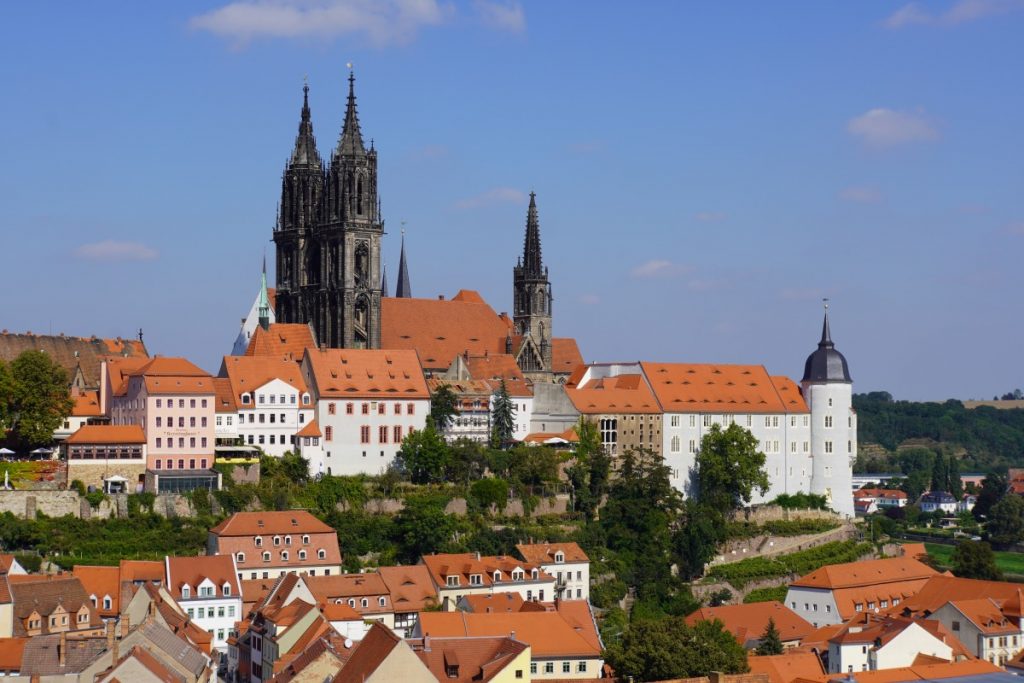
You can reach the cathedral in several ways: for example, you can take the panoramic lift or the bus up the mountain. The footpath is a little more strenuous, with numerous stairs and steeper roads. But honestly, the way up is really beautiful and worth the walk.
Once we reached the top, we stood in front of the church building, impressed. A side entrance leads to the Meissen Cathedral, which can be visited for a fee.
Cathedral building in Meissen
Around 968, Emperor Otto I founded the bishopric of Meissen and initially had a small chapel built. It was not long before a four-tower basilica was erected as an episcopal cathedral church in 1073. This stood exactly on the site where Meissen Cathedral stands today. In its time, this church building must have been quite imposing. However, over time, more modern and even larger churches were built in other cities, which made the church look small and outdated. So a new building was planned, which was initially to be erected directly next to the old building and later replace it.
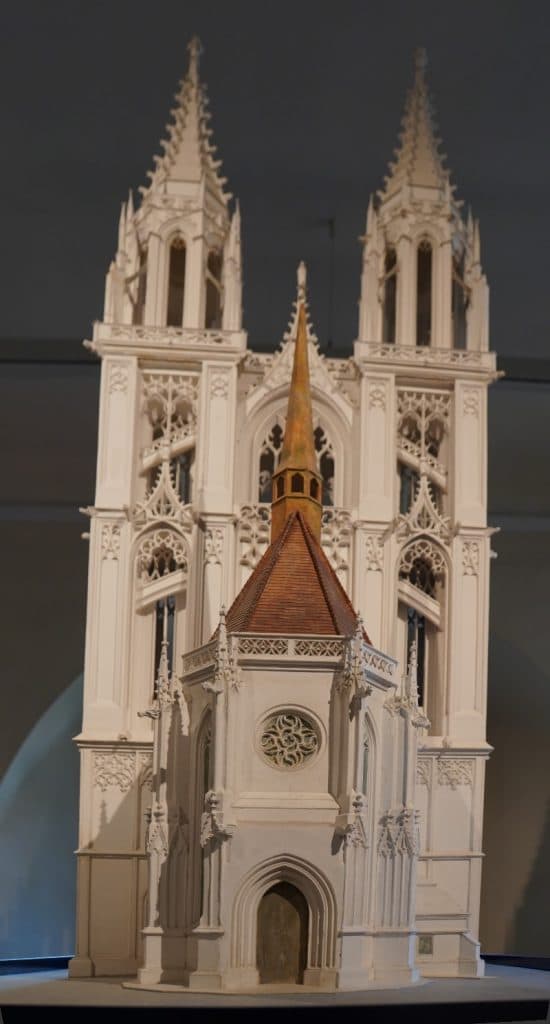
The construction of the new cathedral began in 1260. The individual sections were built piece by piece. First, a single-nave choir and the transept were completed, followed by the All Saints’ Chapel on the east side of the cloister, the octagonal St. John’s Chapel and the chapter house. Around 1410, the nave was finally completed as a seven-bay hall church. This was followed by the construction of the towers, which came to an end in 1909.
From 1990 onwards, Meissen Cathedral underwent extensive restoration work over many years. Today, a visit is a feast for the eyes, with small and larger discoveries in store.
Guided tour up the tower of the cathedral
If you have the opportunity, you should not miss the guided tour up the tower of Meissen Cathedral. Here you can expect not only a great view over the city, but also interesting stories about the cathedral and its towers.

For example, we learn that the “Höckrige Turm” in the south-east corner between the transept and the choir was the only tower of the cathedral for many years. The name of this tower is derived from the unusual bend of the spire. The tower has an open design, the spire consists of individual ribs that form the openwork side surface.
When planning the cathedral, the master builder had already built the basements of the west towers. However, they were not completed. It was not until 1470-1477 that a third storey was added to the towers; the spires were destroyed by a lightning strike in 1547. And so the towers remained unfinished for many years. It was not until 1903 to 1909 that the cathedral’s characteristic towers were built.
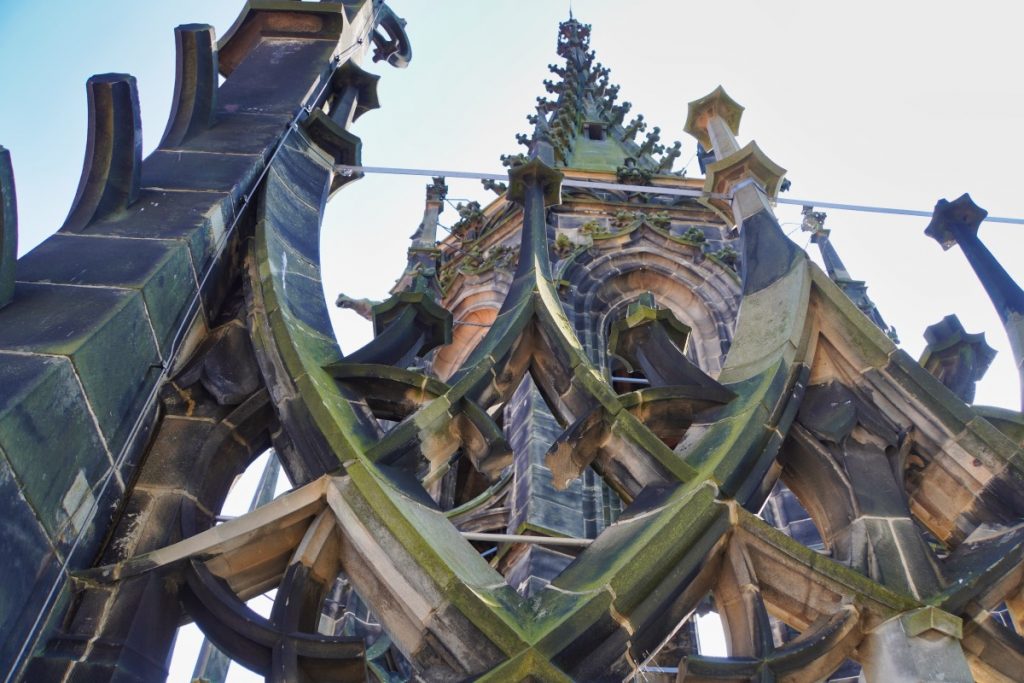
Today, the 87-metre spires tower high above the city. Each spire consists of a stone crown and a weather vane. On the north tower is a weather vane with the coat of arms of the Kingdom of Saxony and on the south tower is the coat of arms of the High Chapter of Meissen. The spires are made of sandstone. It is striking that they have been designed differently. One helmet is characterised by edge flowers, the other helmet by turned pinnacles.
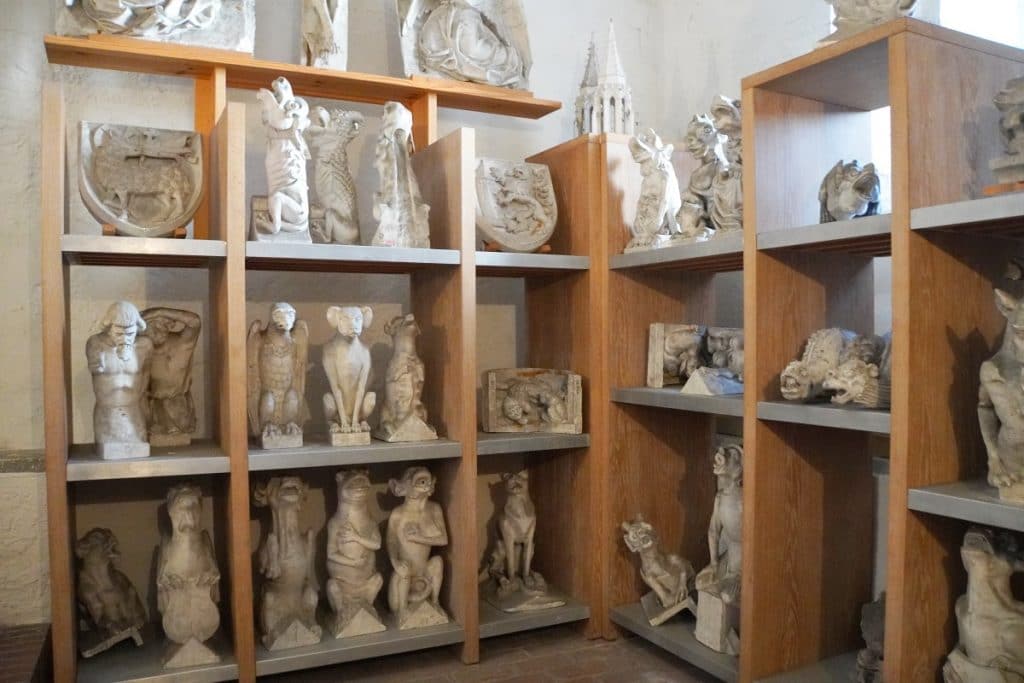
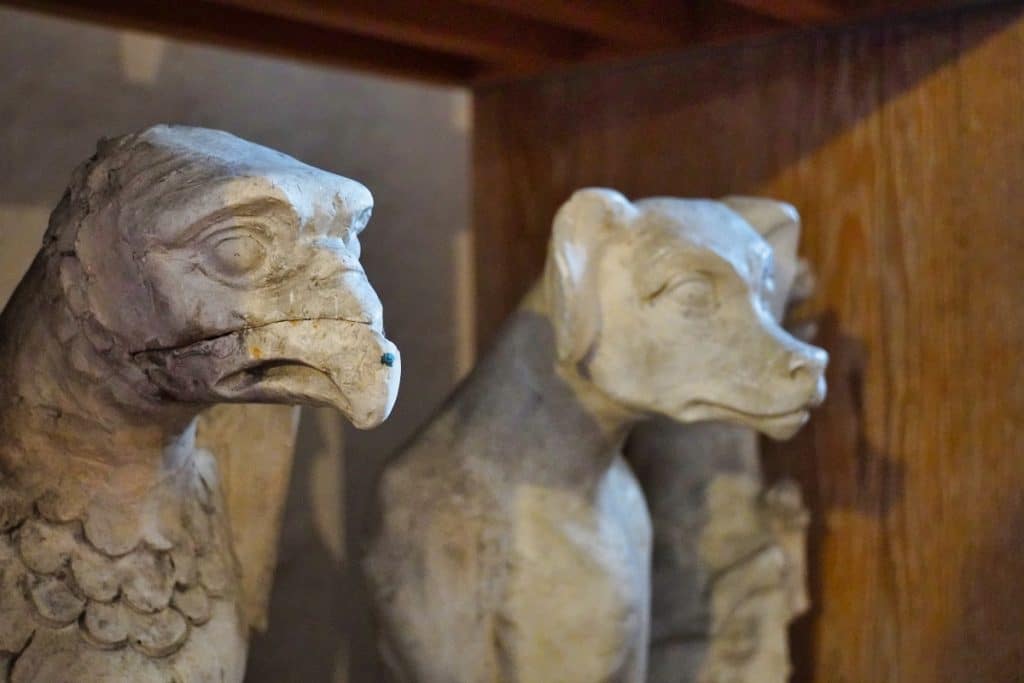
The visit to the tower begins in the cathedral. Through a small door, you enter a small room where numerous figures and ornamental elements were stored on shelves. Some of these were gargoyles, which we would later find on the tower. I was a little surprised to see, in addition to the “usual” frightening-looking creatures, quite pretty-looking birds of prey and even a dog on the shelves.
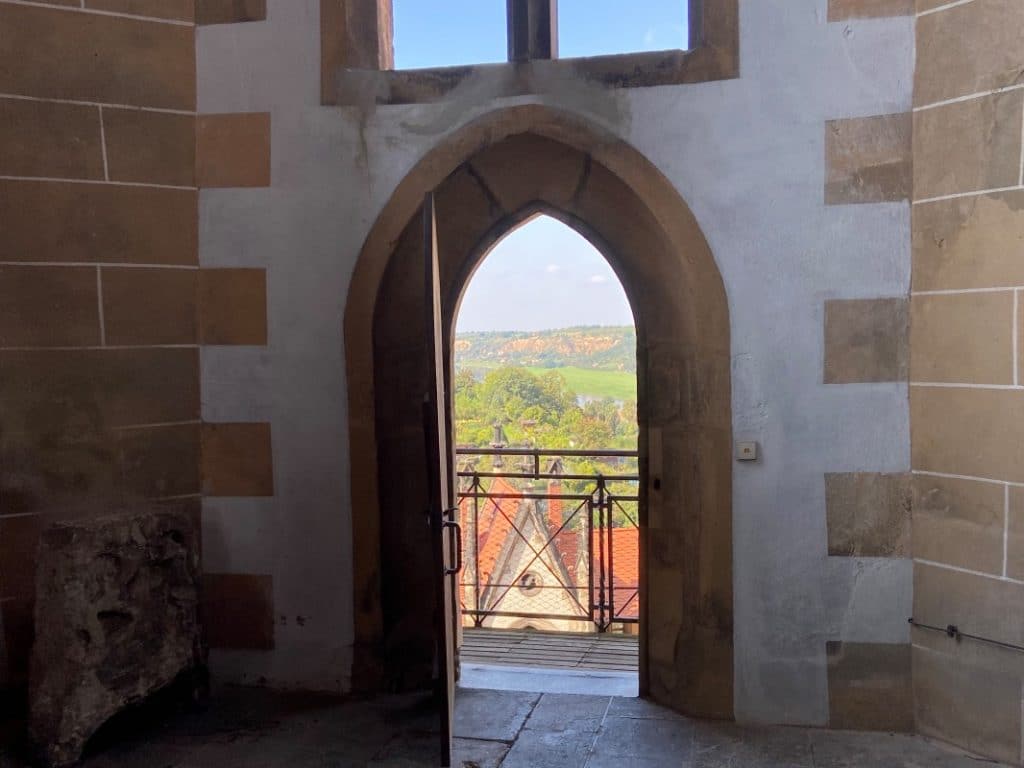
From a gallery you can take a look inside the church and then the ascent of the tower begins. There are a total of 304 stone steps to climb, which take you higher one step at a time.
The first stop is in the tower hall. This connects both towers with each other. You continue upwards via open stairs in one of the towers. These stairs are not necessarily suitable for people with a fear of heights. Although you walk on well-built, stable stone steps, you are not limited at the sides by a wall of the tower. Everything is open and windowless, you climb up in an open tower. But the view you can enjoy on this climb is really impressive. I find it particularly exciting to look down on the neighbouring Albrechtsburg Castle.
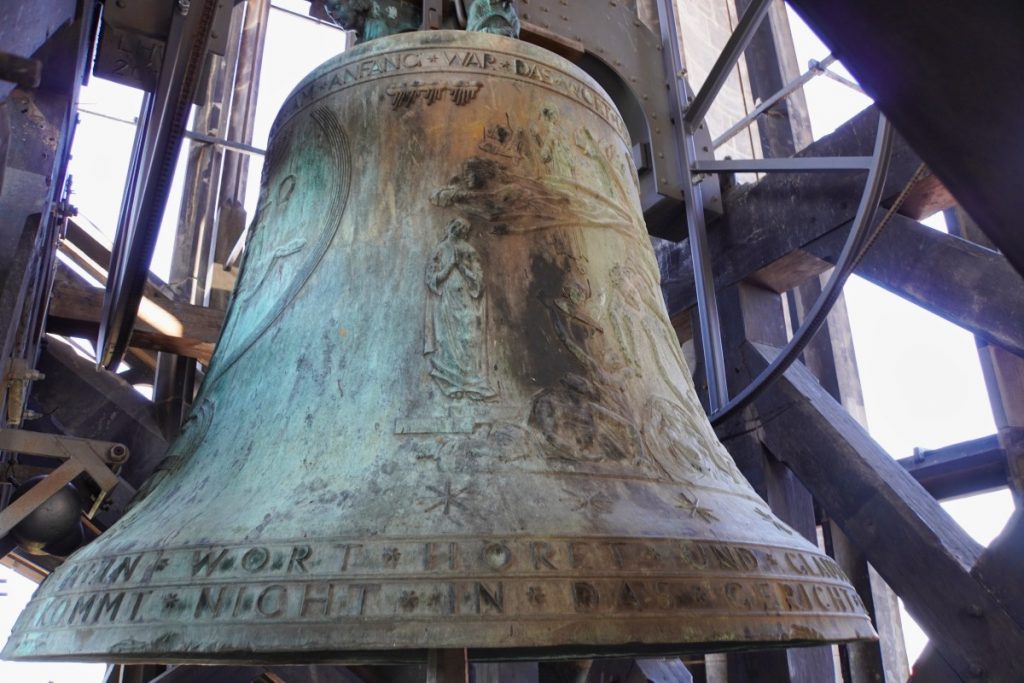
Next you reach the bell storey. The St. John’s bell in the north tower was created in 1929 for the 1000-year celebration of Meissen. It is one of the bells with the most figures in the world and shows various scenes from the Bible. It was almost melted down for armaments production in 1941, but fortunately it was rehung in the cathedral after the war. In 1977, a bracket of the suspension broke. The bell fell down and fortunately got stuck in the belfry. It was put back up again in a makeshift way and a few years later it was repaired on site using the latest techniques. At Christmas 2010, the people of Meissen finally heard the bell ring again after many years.
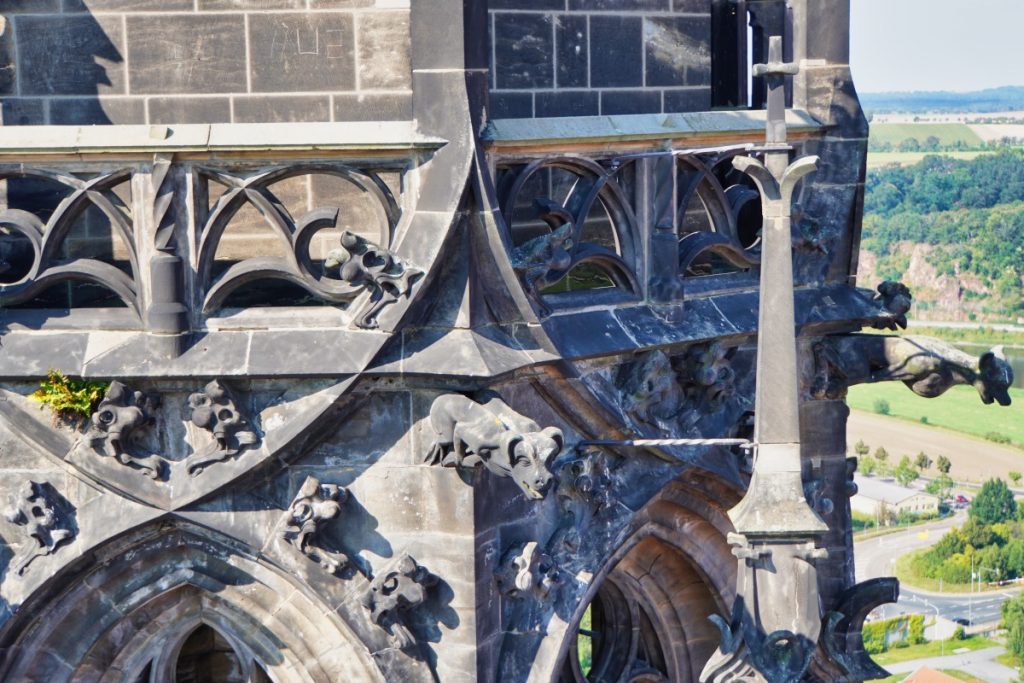
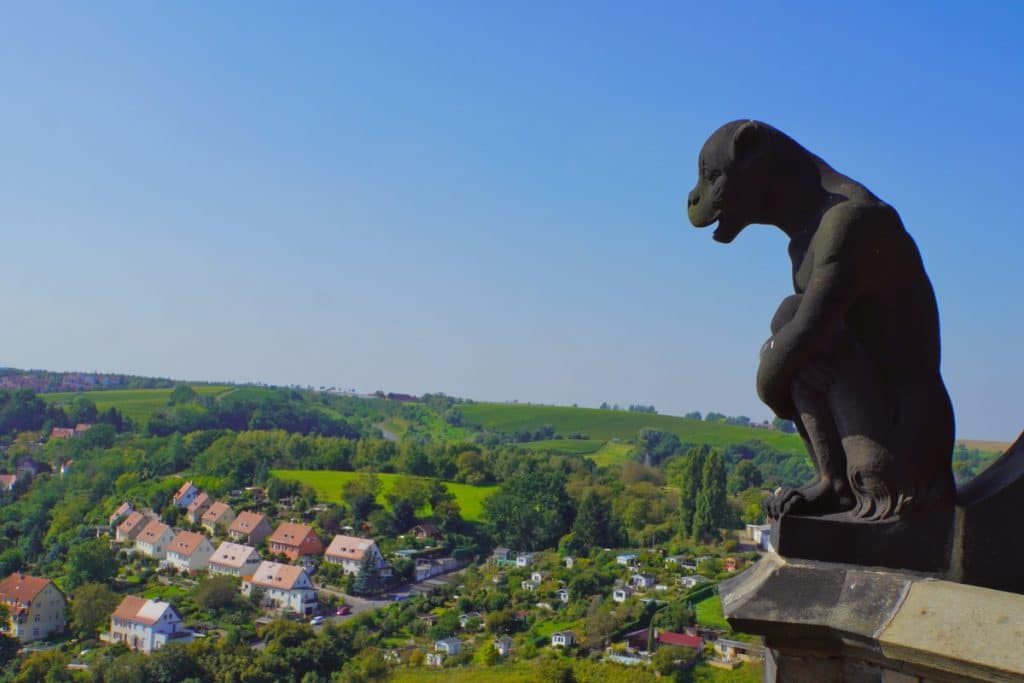
Once you reach a height of about 50 metres, you reach a tower platform that serves as a viewing terrace. The platform forms the central gable between the tower structures. Here you will also find the animal and mythical creatures that we discovered in a small room at the beginning of the tour.
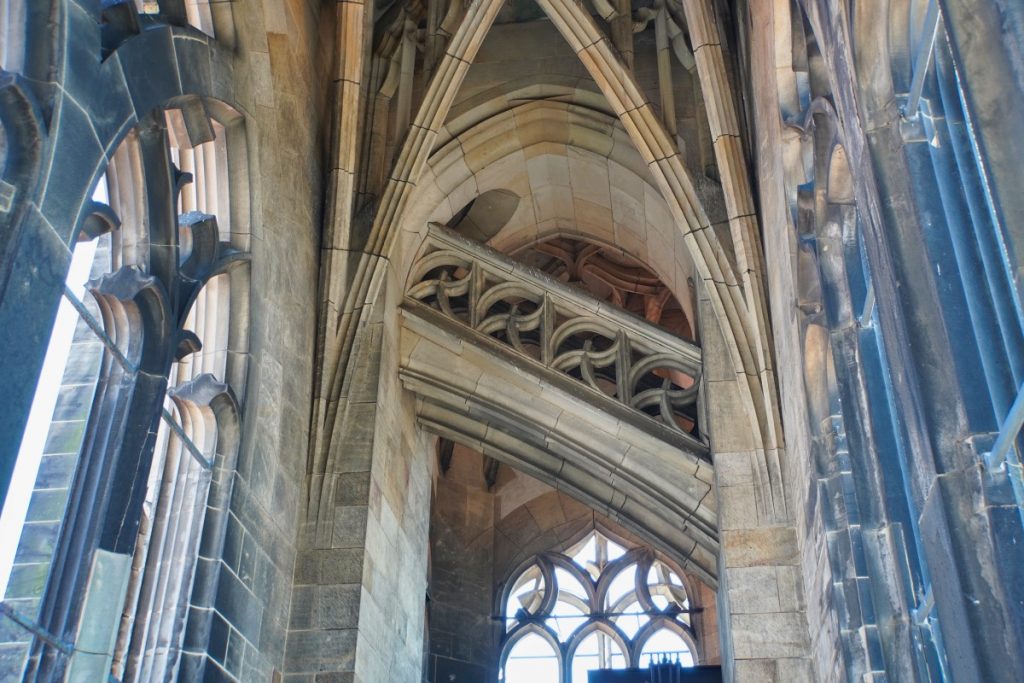
On the square base of the towers, an octagonal storey rises from the platform. The struts form open windows that make the interior open and flooded with light. In the hall of the south tower hangs a relief of the cathedral master builder Carl Schäfer, who designed these superstructures.
If you stand between the two tower structures, you can look at the central gable from behind. At the top is the risen Christ. Further down, not visible from the platform, is the crucified Christ with two angels praying.
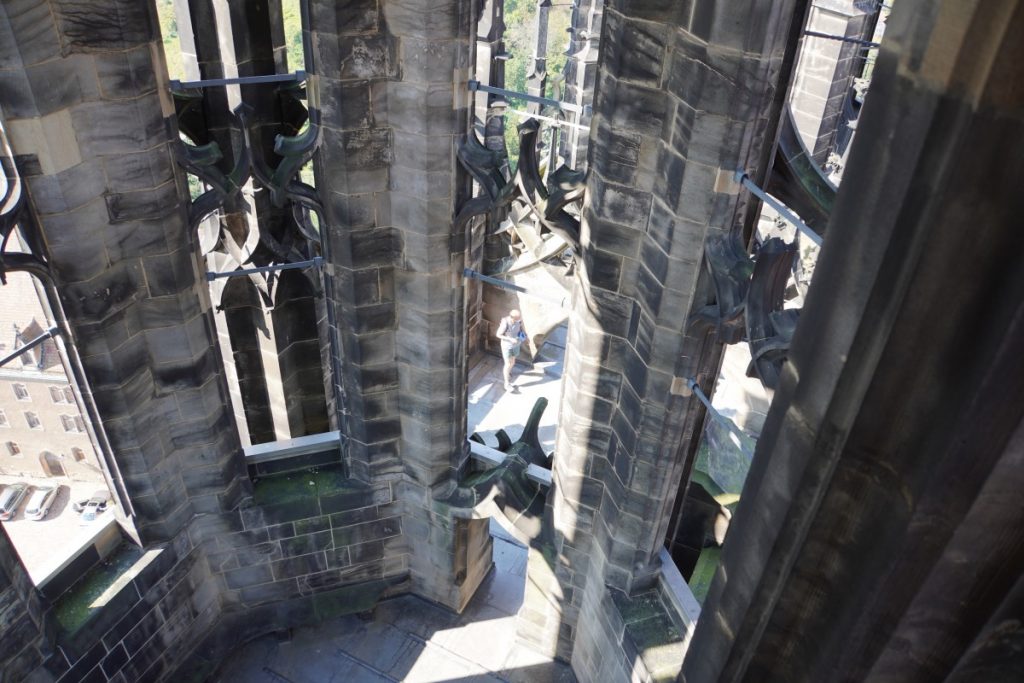
The view from the platform is outstanding and a paradise for photographers. There is so much to see that Patrick stayed there and I continued exploring.
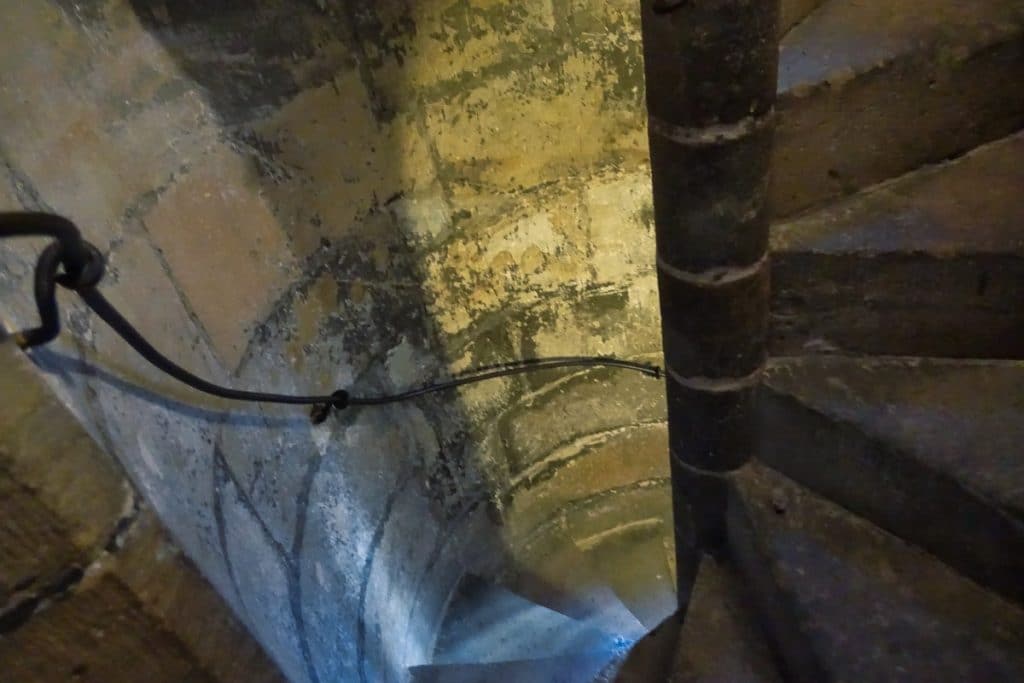
I made my way from to the highest point, which could be climbed during the guided tour. A very narrow spiral staircase led up to the tower gallery directly below the spires. There is very little space here and it took some effort for me to look down from there. But it was worth it. The view is beautiful.
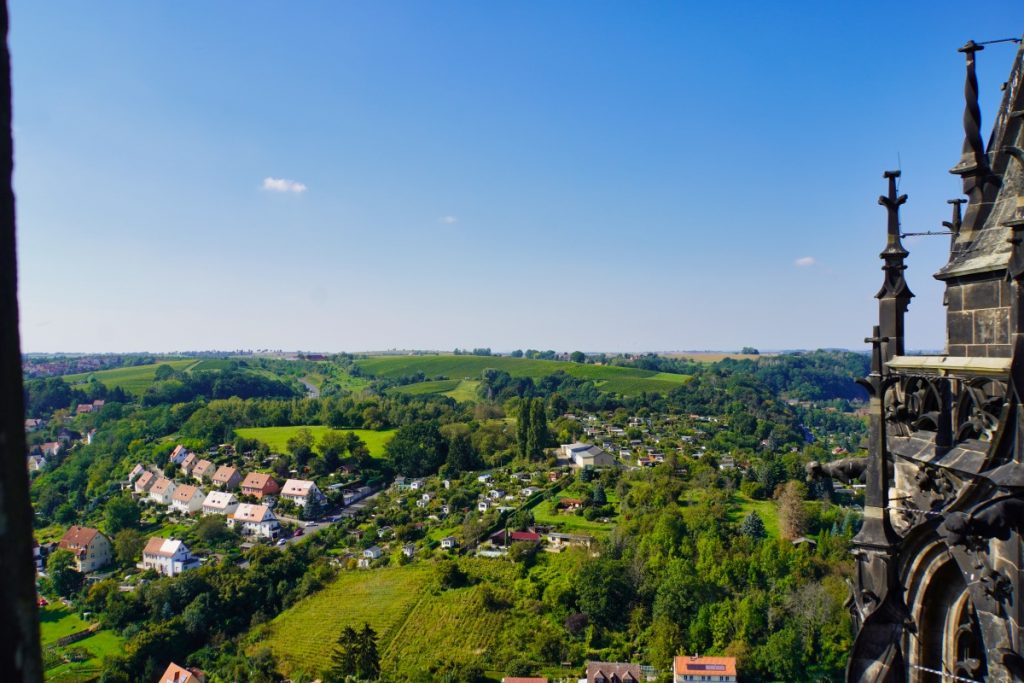
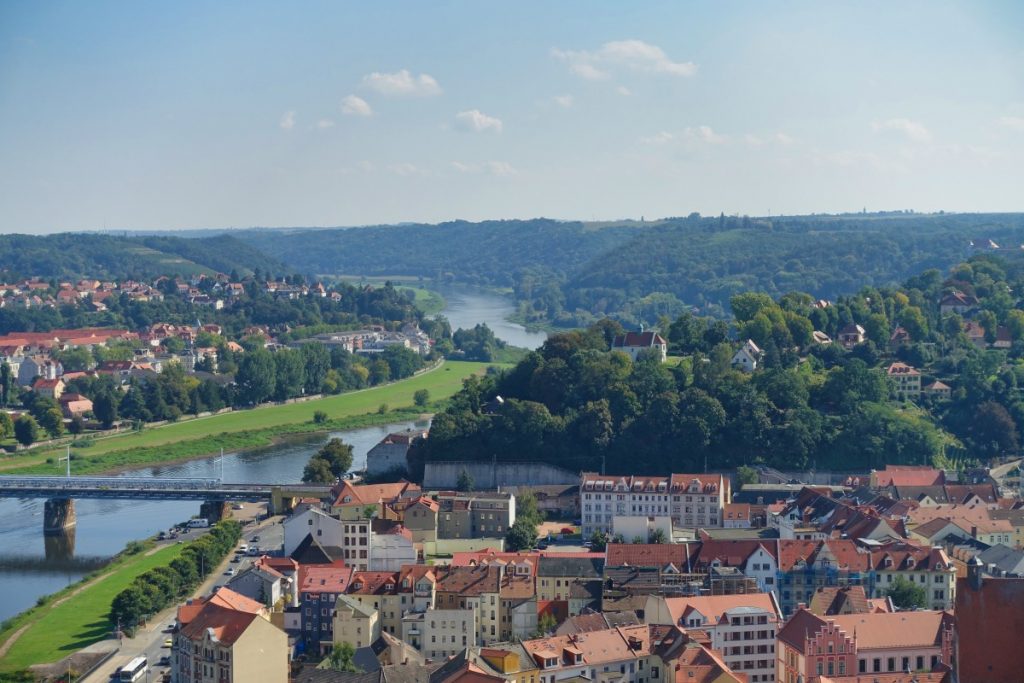
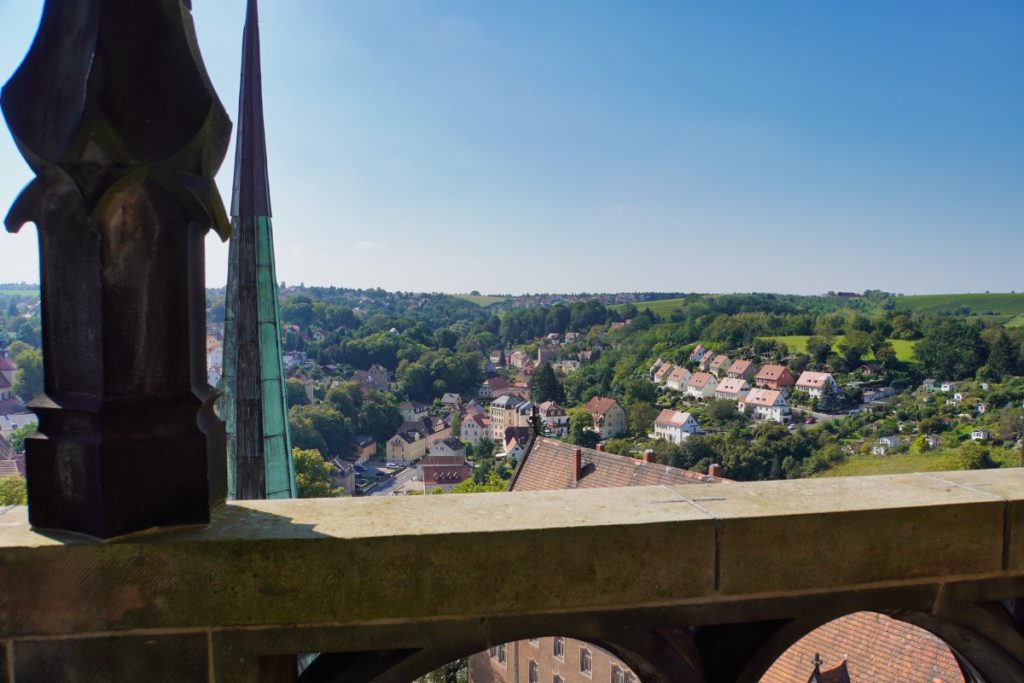
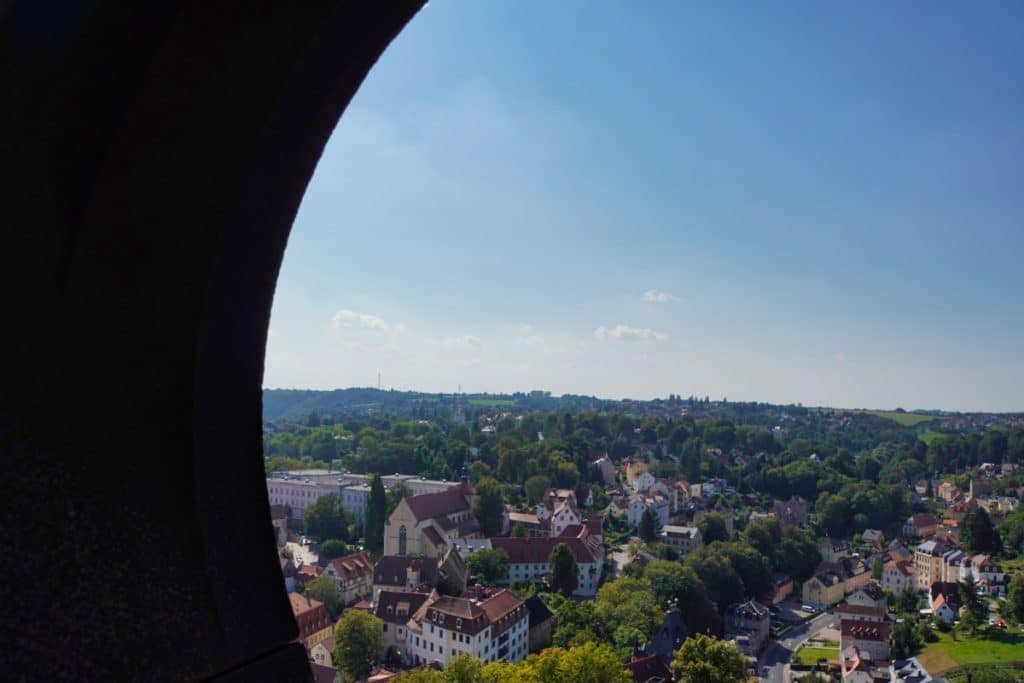
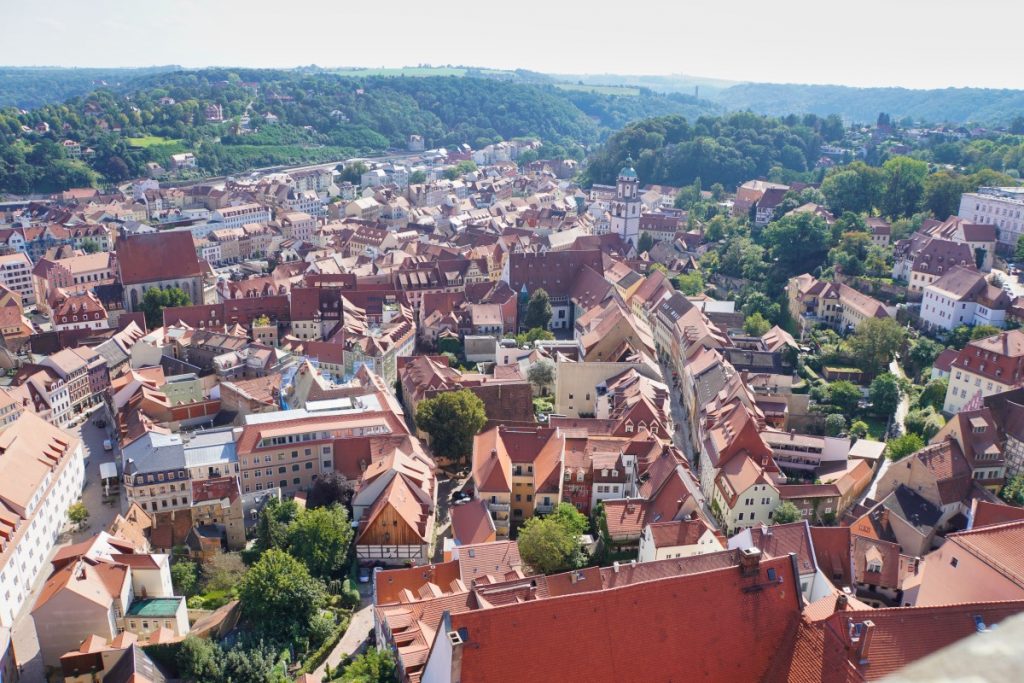
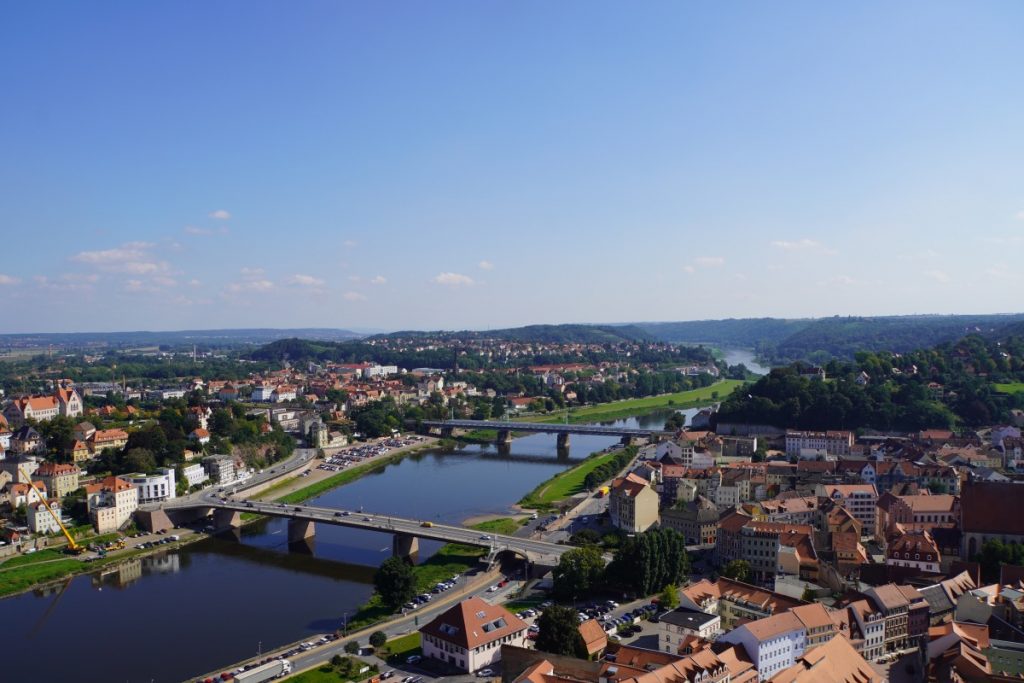
The tour lasts about 45 minutes, even though you could certainly have spent hours up there. On the way down, which was again via the open stairs in the tower, we once again enjoyed the view over the city and the neighbouring region.
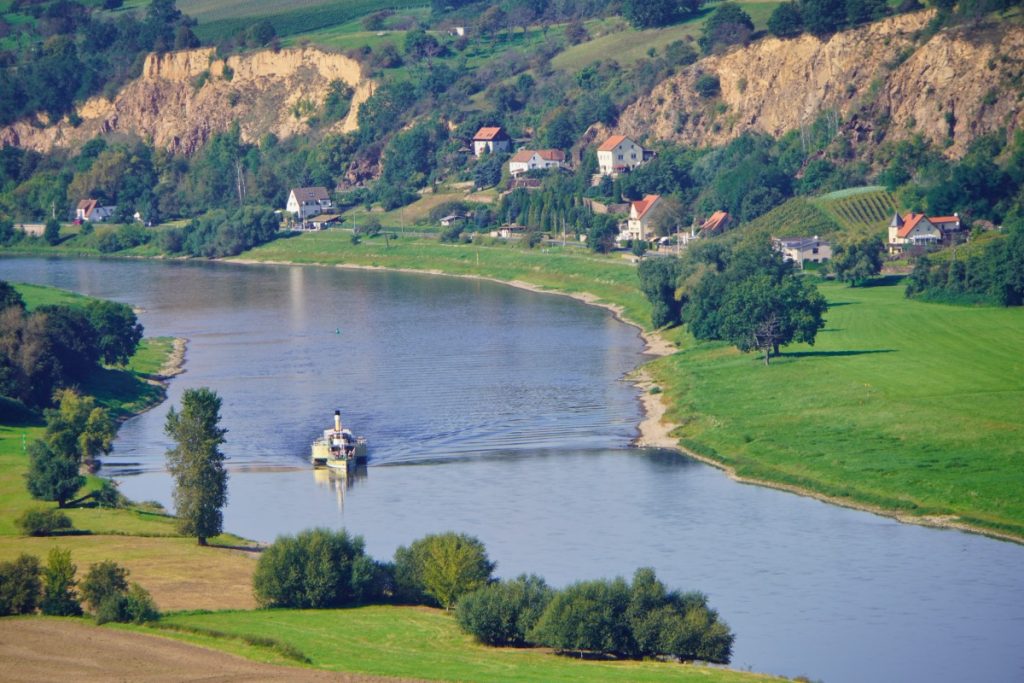
Tour of Meissen Cathedral
If you still have time before or after climbing the tower, you should not miss a tour of the cathedral. We were first drawn to the Prince’s Chapel.
Fürstenkapelle
The Prince’s Chapel was built on the west front of the cathedral around 1420 as the burial place of the Wettin dynasty. Previously, this was the outer main portal of the church, which is now inside the building due to the extension. As a result, the portal is of course very well preserved and one can admire beautiful figurative depictions on the former exterior. The figures date from around 1370 and depict bishop saints and the story of Jesus’ childhood with the Last Judgement.
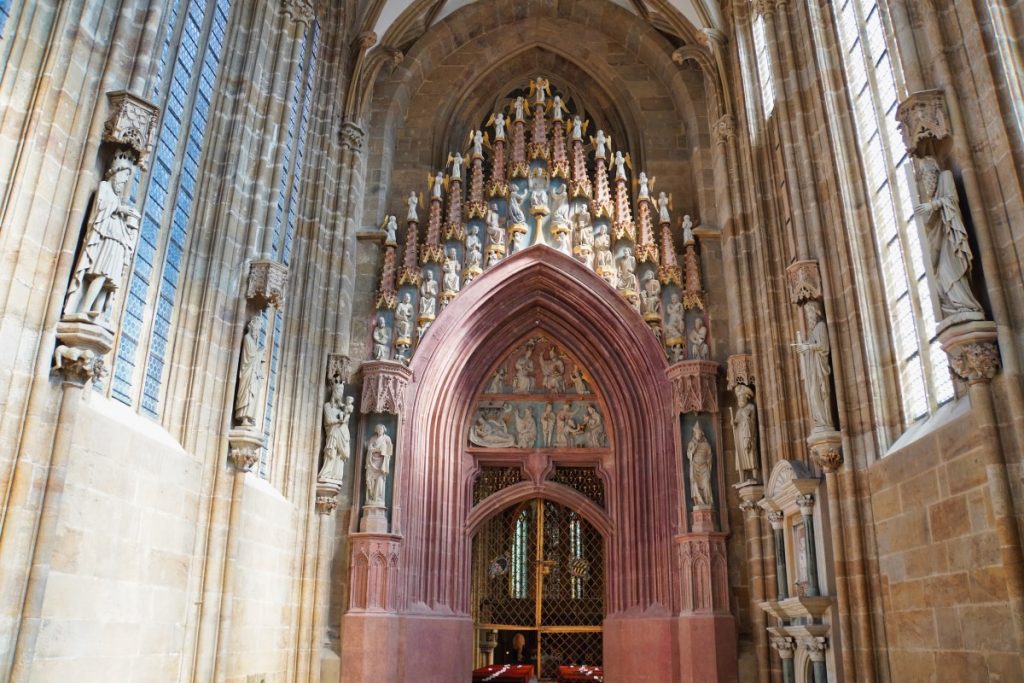
I was particularly impressed by the net vault of the chapel and the lighting. The light in the chapel falls through slender, very high windows designed with fish bubbles, making the room shine brightly.
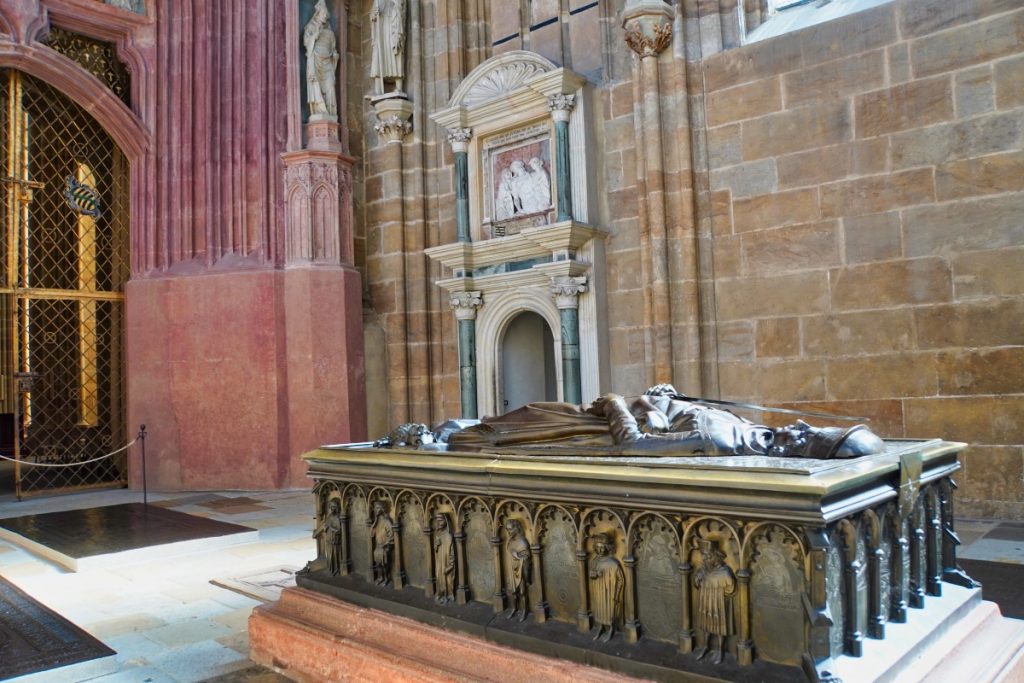
The Saxon electors and dukes were buried in the funeral chapel until 1539. A large bronze burial tumba stands in the middle of the Prince’s Chapel. This is the resting place of Frederick the Quarrelsome. Around the tomb are numerous bronze grave slabs, which are beautifully crafted. And if you look a little closer, you will discover the Dürer mouse on one of these slabs. Why it is depicted there is still not known.
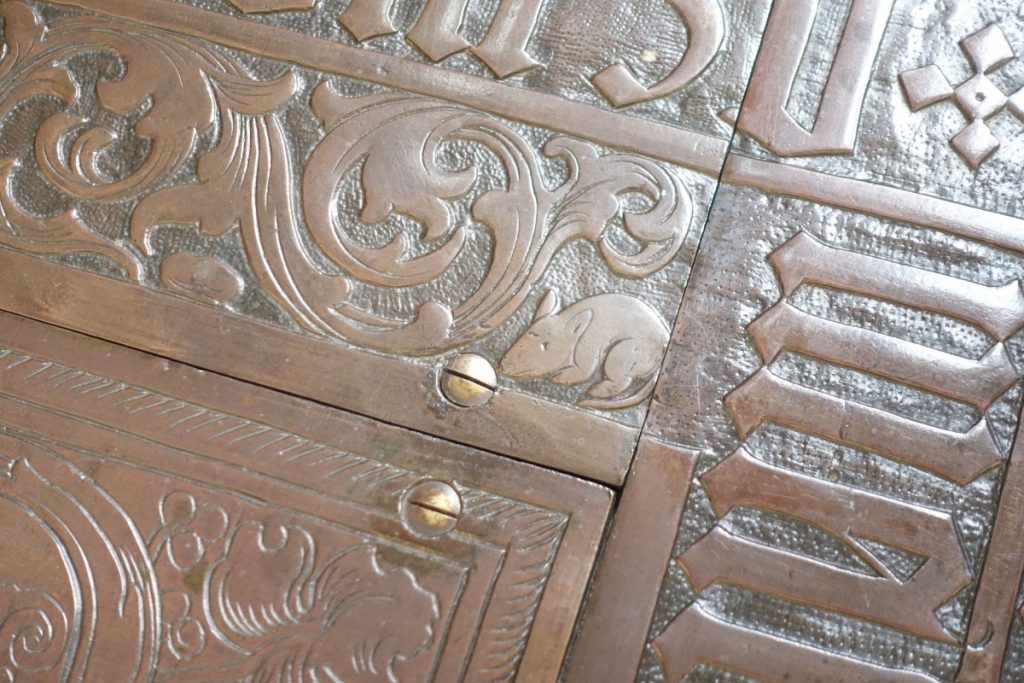
A small door leads from the Fürstenkapelle to the Georgenkapelle. This annex was built around 1530 and serves as the burial place for Duke George the Bearded and his wife Barbara. Recessed in the floor, you can see the artistically designed grave slabs here.
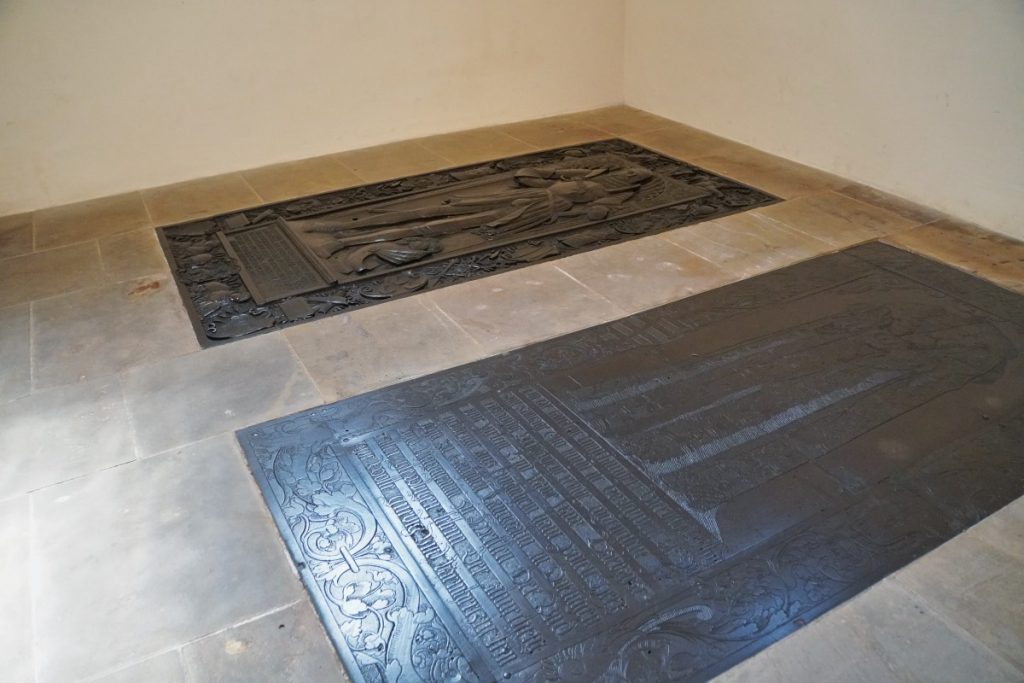
A look at the ceiling is worthwhile – what a beautiful design, with many lovingly worked out details. The stucco ceiling was created around 1670/76 by an Italian artist. The triptych in the chapel is said to have been made by Lucas Cranach the Elder in 1534.
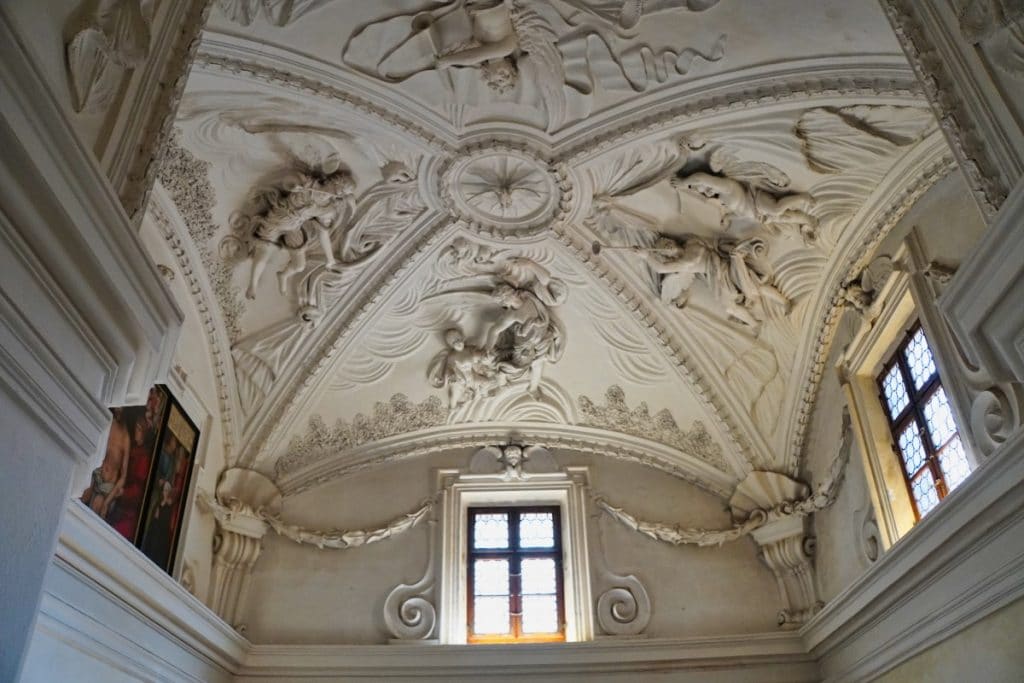
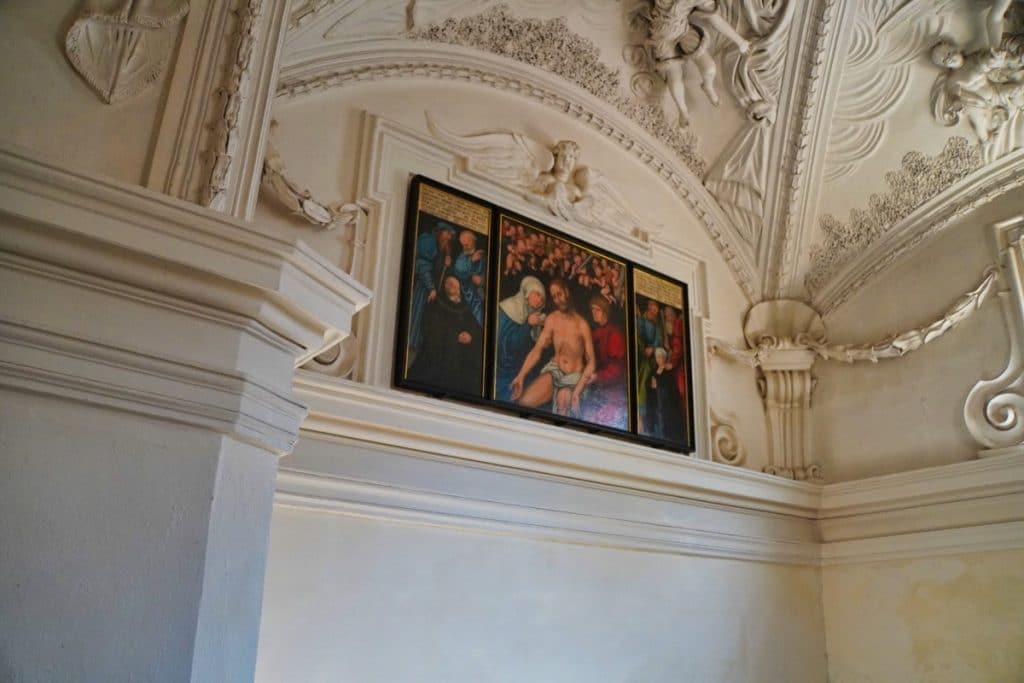
Nave
Our way through Meissen Cathedral led us further into the nave. Since 2017, a simple slab commemorating the grave of Bishop Benno has been located here in the middle of the nave. The burial place of the Meissen bishop was a place of pilgrimage for numerous pilgrims for many years. In 1539, Elector Johann Heinrich had the tomb destroyed.
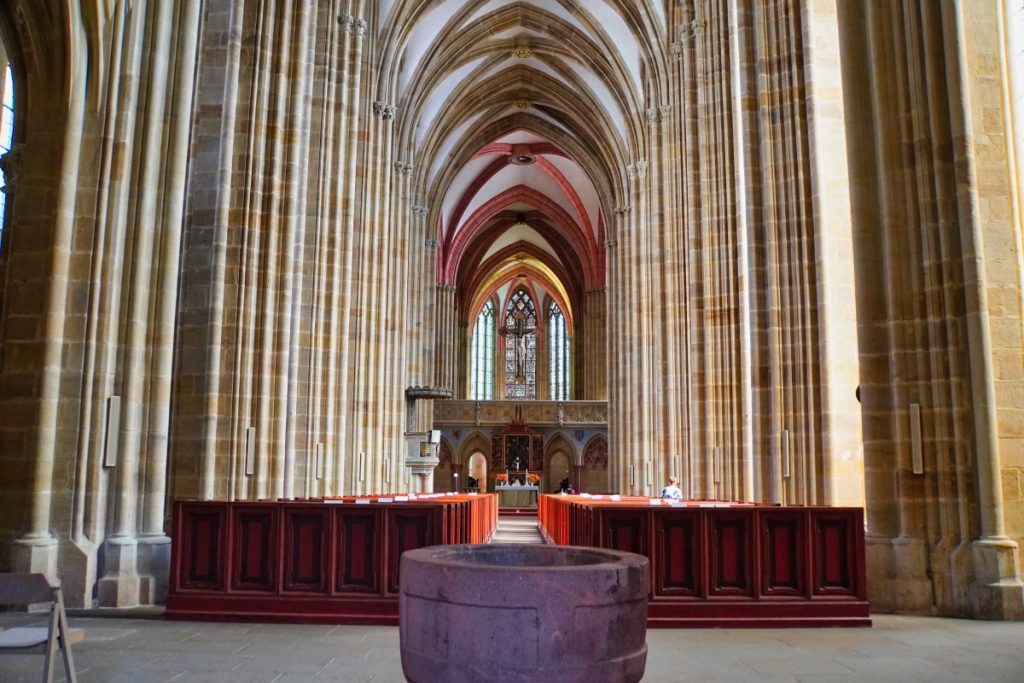
The nave is divided into three aisles, each separated from the others by a row of mighty pillars. A lot of light shines into the nave through the high windows, making the building appear very bright and friendly. The room appears very high.
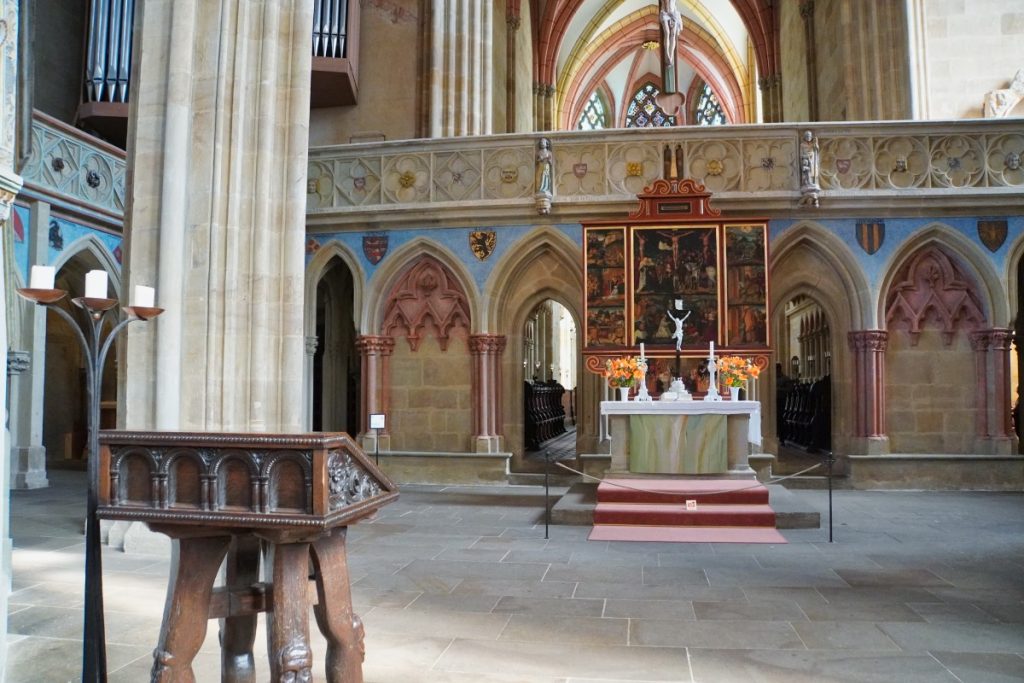
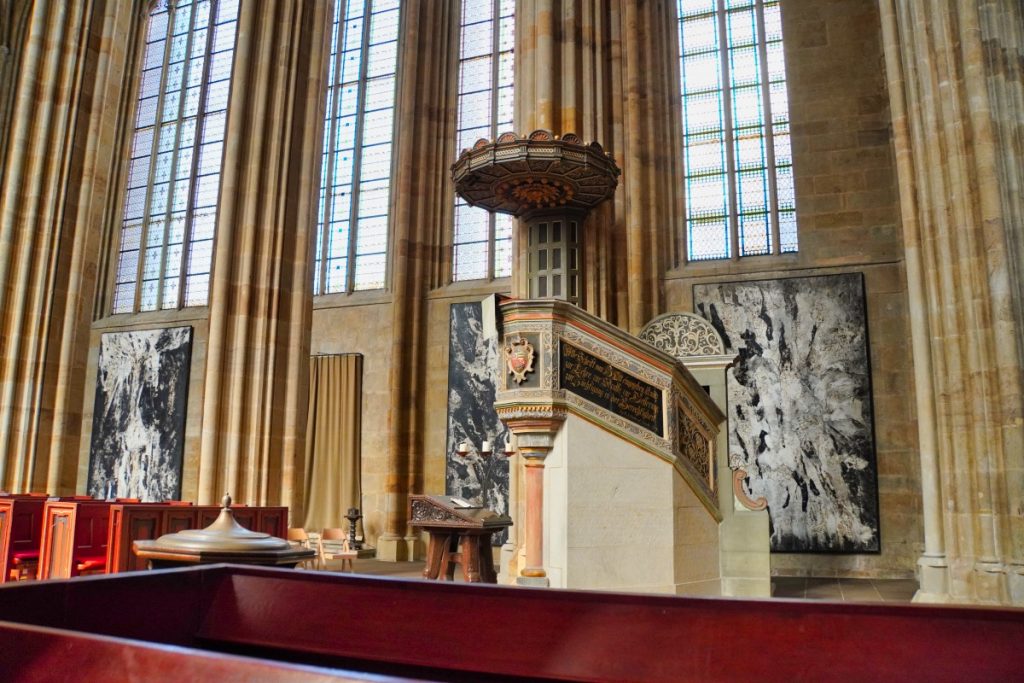
Not only the sandstone pulpit is worth seeing. Behind the lay altar in the nave hangs a triptych designed by Lucas Cranach the Elder.
A very good overview of the nave is obtained by climbing the stairway to the gallery, which is located on one of the long side walls, directly by the small octagonal chapel.
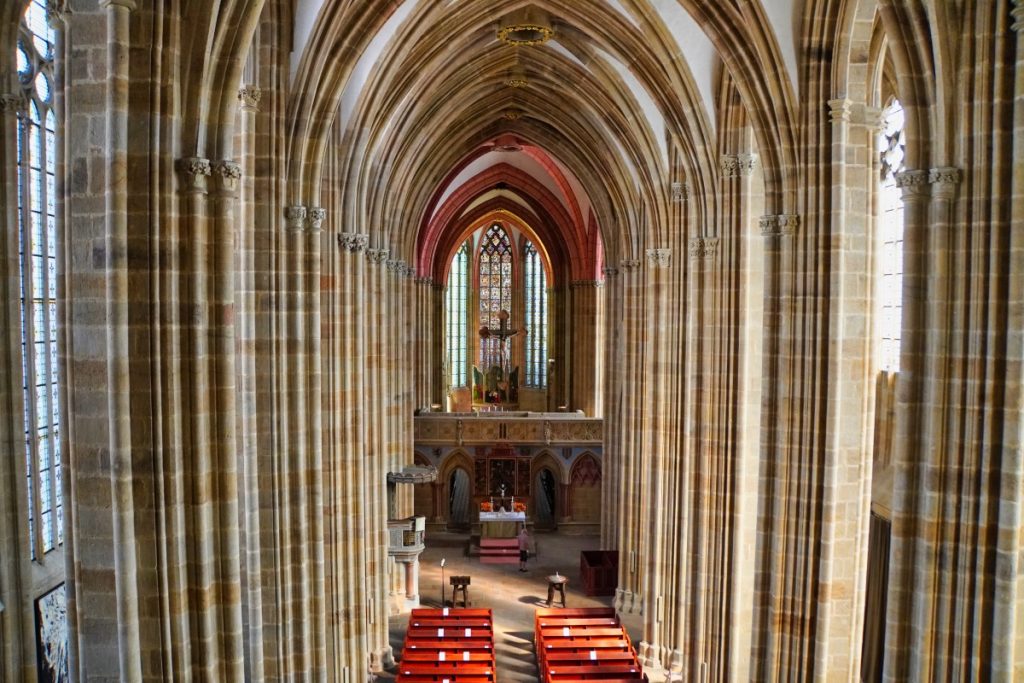
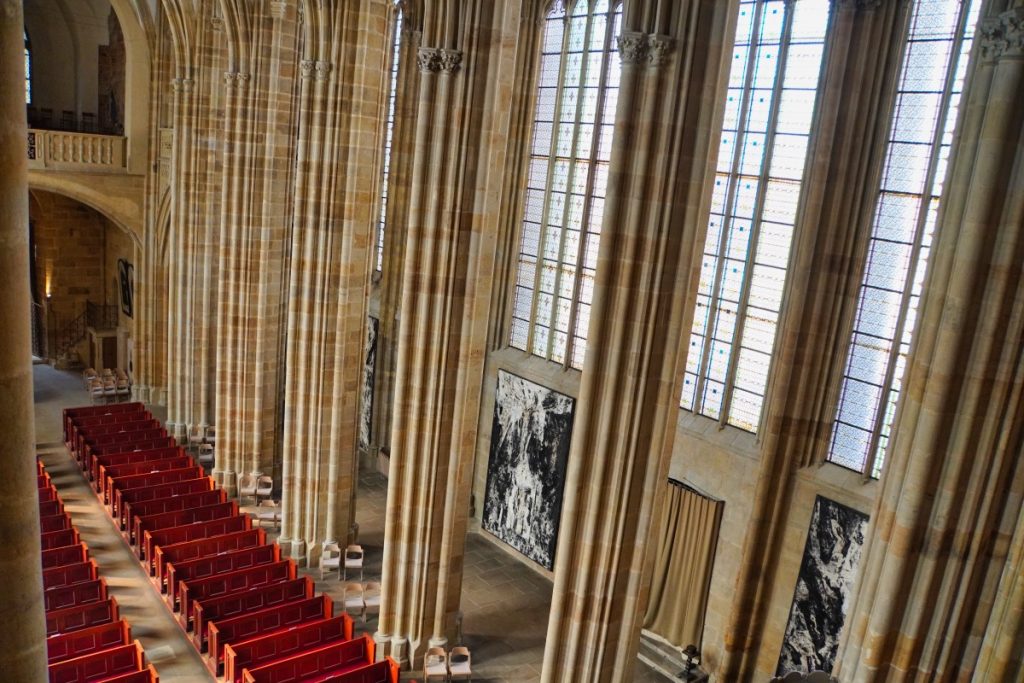
High choir
The visit to Meissen Cathedral took us further into the High Choir. The main altar of the cathedral is in the choir polygon. The room appears very narrow and high, which is certainly also due to the rather low windows. In the high choir, the master builder has succeeded in “directing” the incident light in such a way that it becomes brighter and brighter up to the altar. This additionally increases the depth effect of the room and makes the choir appear larger than it is.
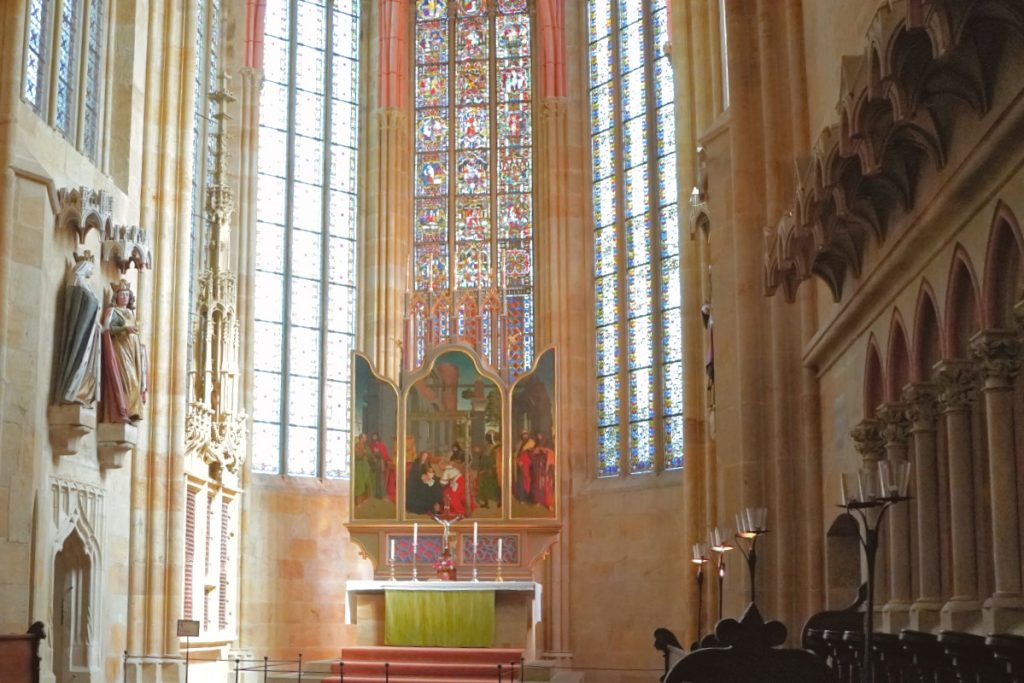
Apart from the window design, the entire choir area is rather restrained and straightforward. The sculptures on the north wall, created around 1260, are impressive. If you look closely, you will discover Otto I with his wife Adelheid of Burgundy.
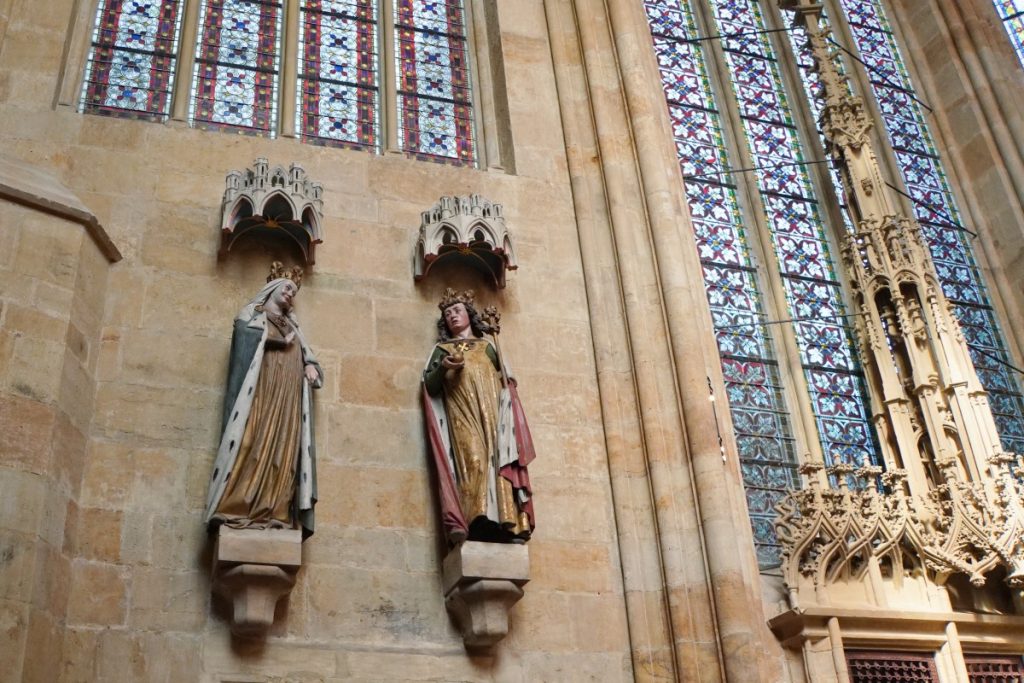
I really like the choir stalls (from 1529) and the high altar. The crucifix and the altar chandeliers were created by a famous porcelain decorator (Johann Joachim Kändler) from Meissen porcelain.
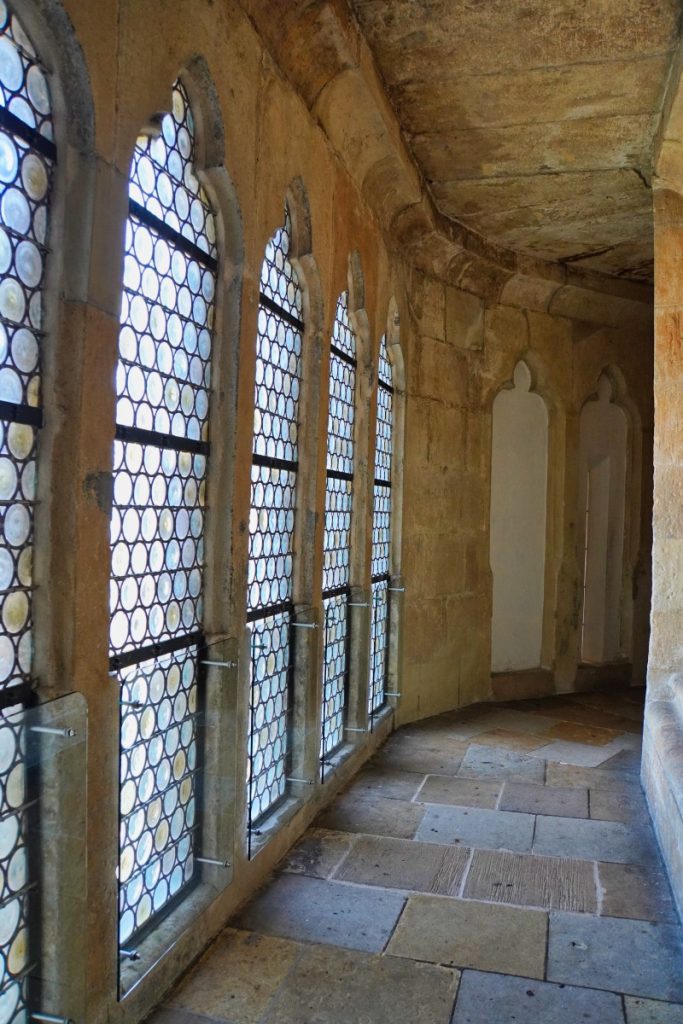
Something special is that the choir is surrounded by a two-storey corridor system. One of these corridors leads from the sacristy to the cathedral museum and into the cloister with the All Saints’ Chapel. The small chapel dates from around 1290 and served as a chapter house. The beautiful cloister on the south side of the cathedral was completed much later, around 1490. Unlike many other cloisters, it is quite small. This is certainly due to the limited space on site.
The sacristy was added to the high choir around 1490. Today, one enters through a late Gothic gate into the room where the clergy dressed for the service. Today you can discover a reliquary, cupboards for vestments and a lot of information about worship. You can also see grave slabs, a small altar and a fireplace (the only one in the unheated cathedral at the time).
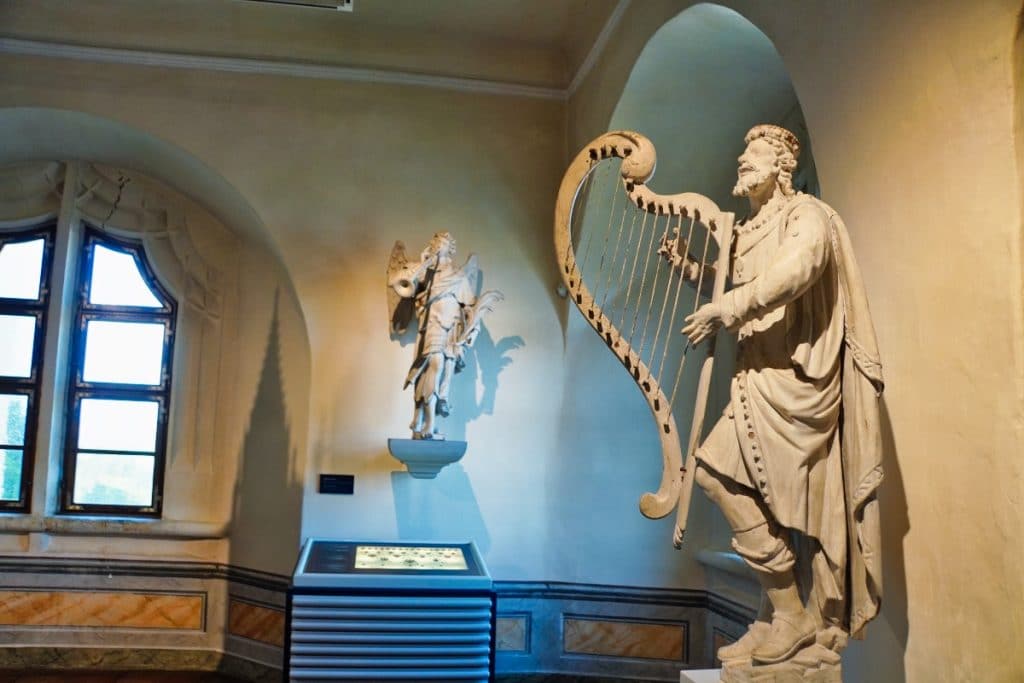
The small cathedral museum is located in an area behind the High Choir. It’s worth a look, you’ll find interesting, well-edited information here.
Another little tip:
Meissen Cathedral not only offers church services and guided tours. There are also smaller and larger musical events. The exact dates can be found on the website and tickets can be purchased online.
Address:
Hochstift Meißen
Domplatz 7, 01662 Meißen
Admission fees:
Adults: 5,00 €
Guided tour of the cathedral
Adults: € 7.00
Tower tours
Adults € 7.00
An individual tour of the cathedral afterwards can take place during opening hours and is included in the admission price.
Reservations by phone 03521 452490 or by email: [email protected]
There are discounts and combination offers.
Opening hours:
daily: 9-18 h
no visitation: during church service, 24 and 25 December
Tower tours:
daily 13:00, 14:00, 15:00, 16:00
Many thanks to the Hochstift zu Meißen and the Public Relations Department for making this visit possible.
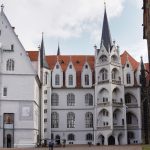
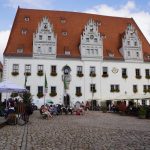
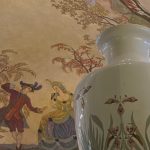
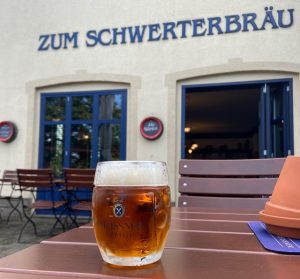
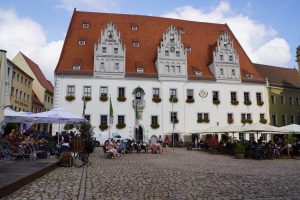
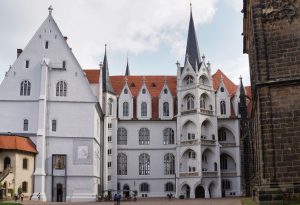

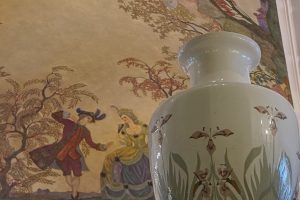
Leave a Reply